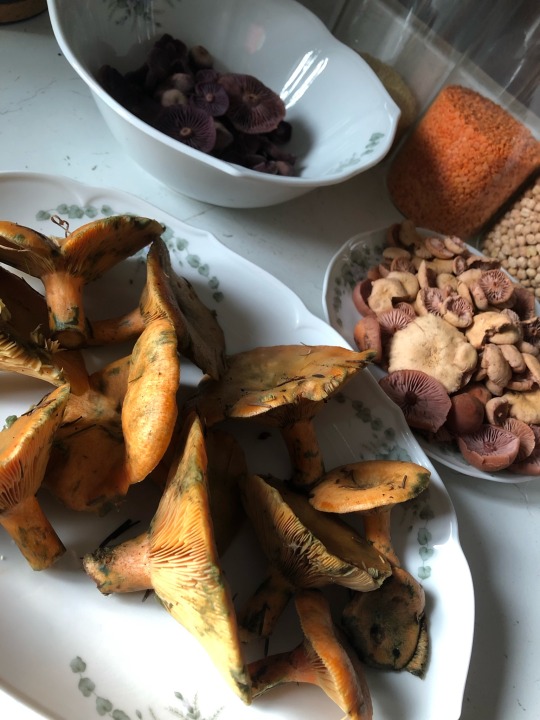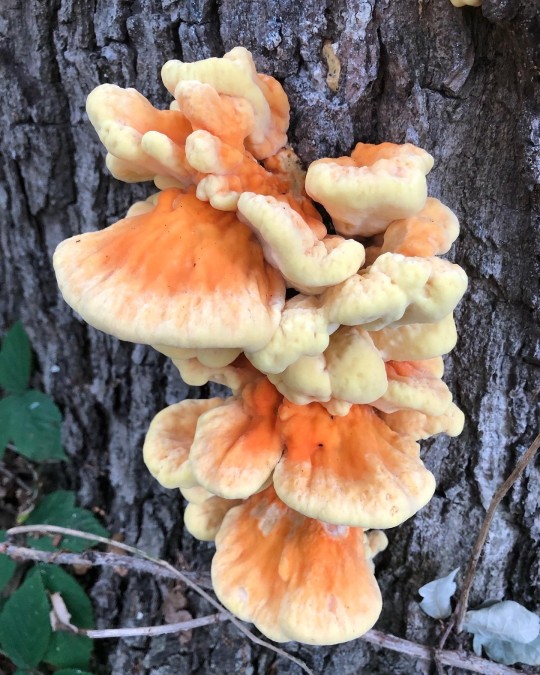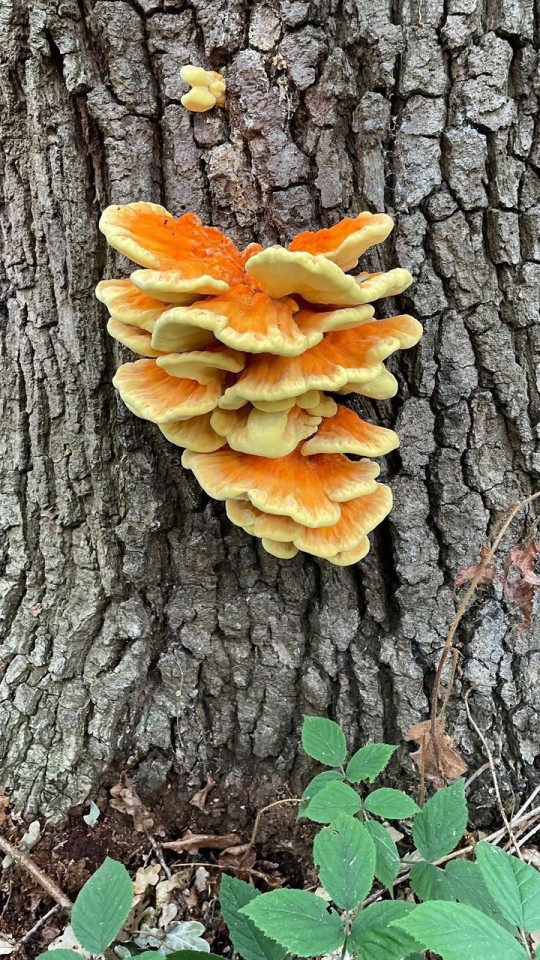Text

Saffron Milk Cap Recipe Suggestion
Garlicky Milk Caps with Onion Rice and Asparagus
If you’re lucky, you’ll get a decent haul of specimens of the same mushroom on a good year. The problem is deciding what to do with them all!
This is not so much a recipe as a suggestion. One of the problems I find with wild food recipes, aside from trawling through hundreds of variations of the same meal, is that quite often the ‘recipe’ is more of a manner of cooking. I love all my foraging guides, but there’s only so many time I can “fry in butter with bacon and salt” before I die of boredom…
I want to know what spices people are using, and what they’re serving on the side! I want to know who thinks it’s a breakfast food and who thinks it’s a decorative garnish.

So, here’s a recipe suggestion for saffron milk caps. They’re fried Spanish style (as suggested by Roger Philips), but as a pile of mushrooms isn’t a whole meal to me, they go with some tasty and complimentary sides.


I’ve actually used false saffron milk caps in this recipe. Though the use of the word ‘false’ in front of a delicious edible mushroom usually triggers panic in a forager, this one is thankfully not a poisonous imposter trying to pull off a very mean trick. In fact, it’s a very similar mushroom- apparently so similar that until recently, both were thought to be one species. The differentiating characteristic is that saffron milk caps (Lactarius Deliciosus) are found under pine, while false saffron milk caps (Lactarius Deterrimus) are found under spruce. The differentiating characteristics of pine and spruce are for another post!
Most foragers seem to recount true saffron milk caps as delicious and their false counterparts as only slightly less so. I’ve not been lucky enough to fine the pine species yet, so I can’t confirm that, but I will say the specimens I used in the recipe below were lacking in flavour but had a very pleasant texture. Luckily, some well seasoned side dishes make this a well rounded meal. Two warnings before the recipe begins; first, never eat a mushroom if you’re not 100% sure what it is; second, if you’re not a fan of garlic, this isn’t for you.

Garlicky Milk Caps with Onion Rice and Asparagus Recipe
Serves 2
Ingredients
5-6 large saffron milk caps, chopped, or more smaller specimens, intact
1 bunch asparagus
1 small onion
1 cup long grain rice
1 bulb garlic
1/2 tsp coriander seeds
1 tsp sweet paprika
Handful chopped fresh parsley, or 1 tbsp dried
1 cup chicken or vegetable stock
Butter, for cooking
Salt to taste
Method:
Dice the onion and add to a saucepan over a medium heat, with a knob of butter, and fry until beginning to brown. Then add 3 cloves diced garlic, paprika, coriander seeds, and a pinch of salt. Throw the rice in the pot and stir through, toasting slightly.
Pour the stock into the rice and cover with a lid. Turn the heat to low and allow to simmer for 15 minutes, then turn off the heat. Don't open the lid at any point until you're ready to serve.
While the rice is cooking, place your milk caps into a pan and set to a medium heat with no fat. Allow them to sweat out any liquid, sprinkling over a pinch of salt to aid the process. Continue to dry fry the mushrooms and allow them to brown slightly, turning the heat a little higher if you need to.
Meanwhile, prepare your asparagus however you prefer. I used a griddle pan to fry the stalks in salted butter over a medium-high heat, turning after a few minutes or once griddle marks appear. For thick stalks, add a spoonful of water to the pan, cover with a loose lid and allow to steam for a minute or until tender.
Once all your components are ready, dice another 3 cloves of garlic and add them to the milkcaps with the parsley. Stir a few times, then serve hot with the rice, asparagus, and a slice of crusty bread.
#foraging#mushrooms#saffron milk caps#false saffron milk caps#milk caps#lactarius#lactarius deterrimus#lactarius deliciosus#saffron milk cap recipe#wild food#wild food recipe#foraging recipe#fungi#recipe#vegetarian
10 notes
·
View notes
Text

Fly Agaric | Amanita Muscaria
Fernilee Reservoir, High Peak
These iconic little toadstools are beautiful and uncanny, like little porcelain ornaments poking out of the moss. They’re also poisonous- and hallucinogenic!
Some peoples have used (and continue to use) the psychedelic properties of this fungus to inform spiritual and religious experiences. Apparently reindeer enjoy a nibble, too. Thankfully, if you want to use it for that purpose, boiling extensively- for about ten hours- breaks down the toxins, so you can enjoy your trip without the very unpleasant gastrointestinal symptoms!
The common name comes from their use, when mixed with milk, to attract and drown flies. A mushroom if many talents…
#fly agaric#amanita muscaria#fungi#psychedelic mushrooms#photo#mushroom lore#forestcore#toadstool#mushrooms#Derbyshire#Peak District
4 notes
·
View notes
Text

Chicken of the Woods Recipe
'Chicken', Leek, and Mushroom Pie
Chicken of the Woods (Laetiporus Sulphureus) is one of summer’s most exciting and unmistakable finds. With its distinctive bright yellow-orange colouring and characteristic globular shape, this is a great beginner mushroom for anyone just dipping their toes into mushroom hunting. It goes without saying though: never eat a mushroom that you haven’t confirmed the identity of using several sources.


Chicken of the woods is a bracket fungus that grows on trees and dead wood. Every specimen I’ve found has been on a beautiful gnarled old oak tree, but they can also grow on cherry, sweet chestnut, willow, and yew. Take care when collecting and pay attention to where they’re growing. Fungus growing on yew can take in toxins from this poisonous tree, and I’ve heard that the occasional specimen on old fence posts can have the same issue with substances used to treat the wood. Be careful and only collect specimens from deciduous trees and stumps.

When picking chicken of the woods, the younger the better. Small fans with bright yellow colouring and rounded edges are in their prime. At this stage, the fungus is a choice culinary delight, with a soft texture similar to chicken- hence the name. As they age, COTW grow into large fans with wavy edges, becoming pale and dry. Once this mushroom is past its best, it has a texture more akin to polystyrene than juicy chicken!
You can find plenty of recipes online for making meals out of chicken of the woods, often capitalising on its namesake as a veggie replacement in dishes traditionally made with white meat. Lots of recipes include breading and frying, which cotw lends itself well to.

The recipe below is another foraged play on a British pub classic- chicken, leek and mushroom pie. Though it seems a little excessive (this is actually a mushroom, leek, and more mushroom pie!) the addition of other mushrooms is important to the flavour. As well as having a texture similar to chicken, cotw tastes similar to chicken too- which is to say that it tastes of very little at all. You can use any other kind of mushroom you like, but the best would be those with a strong, mushroomy flavour. I’ve used dryad’s saddles, but some good foraged alternatives would be parasols, field mushrooms, or any kind of edible bolete. If you rehydrate dried mushrooms to use in this recipe, you can replace some or all of the stock with the mushroom-soaking liquid for extra umami!
Chicken of the Woods, Leek, and Mushroom Pie Recipe.
Ingredients
For the Pastry:
80 grams salted butter
80 grams lard (substitute with more butter to make this recipe vegetarian)
500g plain flour
1 egg, plus one for glazing
For the Filling:
500g fresh chicken of the woods mushroom
2 large leeks
200g other mushrooms (rehydrated weight if using dried)
3 cloves garlic
5tbsp plain flour
200ml chicken or vegetable stock
200ml full-fat milk or single cream
1 handful chopped fresh parsley, or 2 tbsp dried
1 handful chopped fresh tarragon, or 2 tbsp dried (optional)
1 tsp craked black pepper
2tsp mustard powder, or 1tsp English mustard
1/2 tsp paprika (optional)
White wine, white wine vinegar or apple cider vinegar for deglazing
Butter for frying
Method:
Make the pastry using a hot water crust method. Measure out your flour in a large heatproof bowl. Crack the egg into the centre and use a butterknife to stir it into the floure. Heat your fat(s) gently in a saucepan with 200ml cold water until melted. Allow the liquid to cool for a minute or so, then tip into the middle of your flour/egg mixture. Stir quickly with your butterknife to combine. Tip the dough out onto a surface and knead very briefly until smooth. Wrap tightly and place in the fridge to cool for at least an half an hour.
Heat a large knob of butter in a saucepan over a medium-high heat. Clean your chicken of the woods mushrooms and slice away any bruised or soft areas. Cut the rest into small bite-sized chunks. Slice your other mushrooms thickly (if using rehydrated, drain off as much liquid as possible). Throw everything in the pan and fry, stirring frequently, until thoroughly browned.
Thickly slice the leeks and mince the garlic. Once the mushrooms are browned, turn the heat down to medium-low and add the leeks with the garlic. Fry for a few minutes until starting to colour. Deglaze the pan with a splash of wine or vinegar, then add the mustard, pepper, and paprika (if using) to the pan and stir.
Turn the heat to low. Add the flour and stir through evenly, so all the filling is coated. Very slowly pour in your stock, stirring constantly, allowing the flour to absorb all the liquid you've poured in before adding more. Once all the stock has been added, pour in the milk/cream and stir again. Stir in the herbs and allow the mixture to simmer gently for ten minutes, stirring occasionally, until thickened.
Preheat your oven to 190 degrees (fan 170, gas mark 5). Lightly grease your tin. A large, flat tart tin works, but I've used a deep 9-inch cake tin to give the pie a little height. If making a deeper pie, split the pastry into two pieces of roughly two thirds (for the bottom) and one third (for the top). If making a flatter pie, split it roughly in half.
Roll out your bottom piece of pastry into a rough circle big enough to cover the bottom and sides of your dish. You shouldn't need to flour your surface, but you can do so if your pastry sticks. Place the rolled out pastry into the tin and gently press into the sides. Pour the filling into the pie crust.
Beat an egg in a small bowl with a splash of milk. Brush a little of this eggwash around the lip of the pie crust. Roll out the top piece, and place it on top. Use your thumb and forefinger to crimp the edge, then slice off the excess pastry with a sharp knife. Use the offcuts to decorate the top if you're feeling creative, and slice some lines to allow steam to escape. Then brush the top off the pie with more eggwash.
Bake for about an hour, or until golden brown on top. Let the pie cool for ten minutes or so after removing from the oven so it holds its shape better when sliced. Eat as it is, or try it with roast veg and a homemade mushroom gravy!
#foraging#mushrooms#chicken of the woods#chicken of the woods recipe#wild food#wild food recipe#foraging recipe#bracket fungi#recipe#laetiporus sulphureus#pie#vegetarian
13 notes
·
View notes